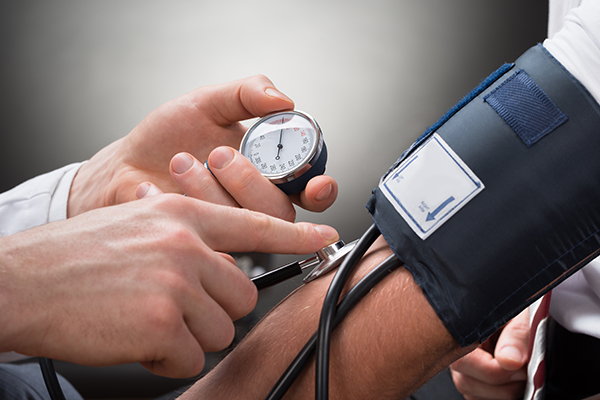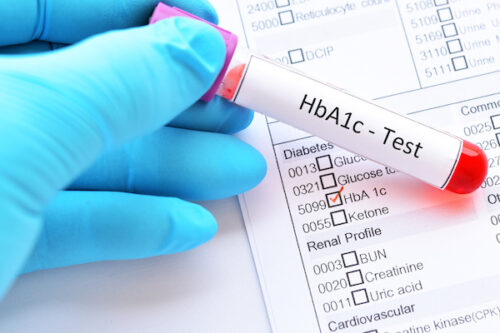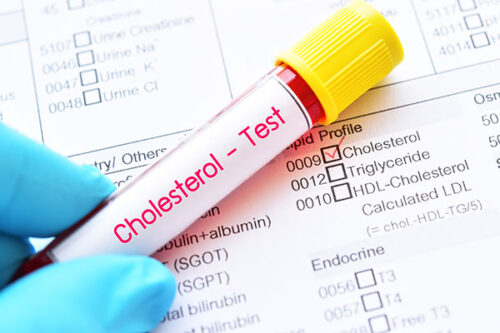The Dangers of Aggressively Treating High Blood Pressure

By John McDougall, MD
If you have high blood pressure, your doctor may insist that your blood pressure must be lowered all the way to “normal” (110/70 mmHg* or less) – but he’s dead wrong. And no matter how much the pharmaceutical companies protest with their billions of dollars of marketing money for research and advertising, over-treatment of your hypertension increases your risk of heart attacks, strokes, and early death.
(*mmHg means “millimeters of mercury” and is the means of expressing blood pressure)
Do not confuse this discussion with naturally-occurring low blood pressure. Without medications a normal blood pressure is 110/70 mmHg or less – and that level is associated with great health.
Lying with Statistics
Your doctor may tell you that by treating your high blood pressure with drugs you will cut your risk of a stroke almost in half. You think, “I’d be a fool to take that risk. If I don’t take the pills I will certainly have a stroke and the medication is unquestionably beneficial.”
The truth is this:
If you have mild hypertension (diastolic – lower number – of 90 to 110 mmHg) your risk of a stroke over the next 5 years is 15 chances of every 1000 untreated patients (or 1.5 in a 100).1
If you take medication, then your risk for a stroke is 9 chances out of every 1000 treated patients for the next 5 years.
Now that is a relative risk reduction of 40% (15 – 9 / 15)1 – And if someone told you that you could reduce your risk of having a stroke by 40%, you might jump at the opportunity.
But in real life (absolute) numbers this is not so impressive. Consider that if you treat 1000 people with drugs for five years, the benefit is only six fewer strokes (15 vs. 9). In other words, by spending thousands of dollars and suffering the side effects (which may include impotency, weakness, or worse) you might reduce your absolute risk of having a stroke over the next five years by less than 1%. (Actually, the reduction is 0.6 in a hundred for five years, which calculates out to about one in a thousand fewer strokes per year of treatment.)
You Deserve Better Than Drug Therapy Can Offer
Faced with these numbers you might think again. Or better yet you might decide that a change in diet and lifestyle, which costs nothing, with no side effects and far greater benefits, might be well worth all your efforts (especially since you now realize you are not going to be saved by the pharmaceutical industry).2
Treatment of elevated blood pressure with medications has some benefits; but, aggressive treatment does not bring risks even close to normal. For example, over a 3-year period, men (40 to 59 years old) were found to have a 21% risk of death from stroke and a 20% risk of death from a heart attack even though their pressure was reduced from 183/114 mmHg to a level of 149/91 mmHg with medications.3 This compares to a 1% risk of death from either disease for people without hypertension (133/80 mmHg) over this same 3 year trial period. The obvious conclusion is you want to be a person without hypertension and you accomplish that goal for free by following a healthy diet and lifestyle.
The J-Curve of Mortality
Many studies of people treated for elevated blood pressure with medications have shown that when blood pressure is reduced below a certain level, risk of serious trouble (heart attacks, strokes and deaths) will increase.4-15 This relationship is referred to as a “J-shaped” curve. Meaning: lowering the pressure to a certain point is beneficial (that is the first part of the “J” shape), but beyond that point, the patient is harmed (the second part of the “J”) when the pressure is lowered further toward “normal.” This phenomenon is found with both systolic (top number) and diastolic (bottom number) pressure changes.
Data presented at the 2004 annual meeting of the American College of Cardiology reaffirmed the “J-curve.”16 A study of 22,576 patients treated for hypertension showed that the death rate dropped until a nadir (lowest point) was reached at a diastolic pressure of 84 mmHg. When the diastolic pressure fell below 84 mmHg, then patient deaths and heart attacks rose again. For example, those with a diastolic of 70 mmHg had 20% greater risk, at 65 mmHg the risk was 80% greater, and at 55 mmHg the risk was four times higher than at 84 mmHg.
People treated for isolated systolic hypertension (a case where the systolic pressure is high, but the diastolic is normal or low) are particularly vulnerable to the harms from over-treatment.17,18 Your well-meaning doctor has been taught by the pharmaceutical companies that it is the duty of every good physician to make patients’ blood pressures normal at all costs, even when the top number is the only one out of range. Two studies have shown that the J-curve applies to isolated systolic hypertension and the risk of strokes, too. The Systolic Hypertension in Elderly Program study found a 14% increase in strokes in those whose diastolic pressure was lowered only by 5 mmHg with medications (starting average of 177/77 mmHg).19 Overall, the research suggests the greatest benefit for stroke prevention is to reduce the diastolic blood pressure no lower than 85 mmHg.17
Why Low BP Kills
The reason too aggressive treatment of hypertension with medications causes serious harm is because the artificially lowered blood pressure impairs the flow of blood to the tissues of the heart and brain.5,15 The small blood vessels supplying these vulnerable tissues are the ones most affected. The flow of blood to these vital organs can become low enough to cause death of tissues, resulting in a heart attack or stroke. Even before the point of causing death of the heart muscle, an inadequate blood supply can cause irregular heartbeats (arrhythmias) of the heart, which are often fatal. Therefore, great caution must be taken in order to prevent lowering blood pressure too much when medications are used.
Over-Treatment of BP Can Cause Loss of Brain Function
In line with the recent findings that blood pressure medications compromise the circulation to vital tissues, a recent study found low treated blood pressure was associated with poor thinking, and mild hypertension was associated with better thinking.20 By over-aggressive lowering of blood pressure with medication function of the brain in the elderly was found to be impaired. The best brain function was associated with a blood pressure of about 159/85 mm Hg (a level consistent with the lowest risk of strokes, heart attacks, and deaths). This loss of intelligence may be permanent in some cases. Just published in the journal Stroke are the findings that patients whose systolic blood pressure (the top number) dropped 15 mmHg or more in six years or less had triple the risk of Alzheimer’s disease, or other forms of dementia.21 Their findings indicate that poor blood flow to the brain, resulting from a decline in blood pressure, in some cases from over-treatment with anti-hypertensive medications, promotes permanent loss of brain function – dementia.
How I Treat Hypertension
When I find a patient has an elevated blood pressure reading in my office, my approach is to recommend the following to the patient:*
1) Don’t panic; your high blood pressure may be secondary to excitement, stress, pain or another reaction completely unrelated to the health of your arteries; and it likely will normalize on its own.
2) Begin taking your blood pressures at home and record the results so that we can discuss them later. Blood pressures obtained in an office setting are notoriously inaccurate, because of the “white coat syndrome.”22
3) Obtain other information that may help establish your level of risk for future health problems – these are called “risk factors” and are such well-known measures as body weight, and blood cholesterol, triglycerides, and sugar.23 A patient’s history and physical examination are also very helpful in determining the urgency to treat. The decision to treat is a judgment (best guess) that is made by the doctor, and should be made with the patient’s full participation in this decision – after all this is usually a lifetime commitment.
4) Doctors usually say that once you are on medications for blood pressure you will be on them for life. This is true only if you fail to understand three important things: 1) the actual benefits and risks of these medications; 2) the fact that a healthy diet will lower blood pressure to normal in most cases and medications can be stopped; and 3) exercise and associated weight loss are also powerful tools for reducing blood pressure and improving general health. Therefore, I strongly recommend a healthy diet (low-fat, plant-based and low-sodium), moderate exercise (like walking), and stopping coffee and tea (see my article on coffee here, from my July 2004, McDougall Newsletter).
5) If after several months (at least 3 to 6 months) of recording blood pressures of 160/100 mmHg or greater (on average) I may recommend drug therapy.23,24 Failure to respond to recommendation four (4) above may be because the patient will not comply with the recommendation to change his/her diet and exercise, or occasionally because all efforts are still insufficient to meet the goal of a blood pressure below 160/100 mmHg (on average).
6) My drugs of choice are time-honored, inexpensive, well-tolerated diuretics and beta-blockers.23,25 I rarely use the high-tech, expensive medications like ACE inhibitors. I never use “calcium channel blockers” because these drugs increase a person’s risk of death and disease (more heart disease, cancer, bleeding, and suicide) and decrease cognitive function.26,27
7) My goal is to reduce the diastolic blood pressure to no lower than 85 to 90 mmHg. A systolic blood pressure of about 140 mmHg makes people happy too – however, I do not routinely lower systolic blood pressure, regardless of the original level, with medications, if that means also reducing the diastolic pressure below 80 mmHg – the risks are too great for more stroke and heart attacks. (Remember, without medications a blood pressure of 110/70 mmHg or lower is ideal.)
8) I often use other medications which lower risk factors like cholesterol – “statins” are a class of cholesterol-lowering medications I commonly prescribe after I have squeezed every possible benefit from a healthy diet. My goal is to have total cholesterol below 150 mg/dl (LDL-cholesterol below 80 mg/dl). (See my June 2003 Newsletter article: “Cleaning out Your Arteries”.)
Blood pressure is a number – George and Martha are people. Doctors must first, last, and all the way in between, be focused on the patient and never do harm by treating numbers at the patient’s expense. In other words, a doctor should never brag that his patient had a normal blood pressure from intensive drug therapy during the many months prior to his stroke or heart attack.
*These are general guidelines that I use and I individualize each patient’s care based on other aspects of general health and needs. You must work with your personal physician on your health issues, and if you are going to use this information, please do so in the context of this very valuable doctor-patient relationship.
To learn more about treating high blood pressure, watch these videos:
John McDougall, MD: Hight Blood Pressure Myths Busted
John McDougall, MD: How to Beat High Blood Pressure with Diet
References:
1) Cook RJ, Sackett DL. The number needed to treat: a clinically useful measure of treatment effect. BMJ. 1995 Feb 18;310(6977):452-4.
2) Erlinger TP, Vollmer WM, Svetkey LP, Appel LJ. The potential impact of nonpharmacologic population-wide blood pressure reduction on coronary heart disease events: pronounced benefits in African-Americans and hypertensives. Prev Med. 2003 Oct;37(4):327-33.
3) Hansson L. Antihypertensive treatment: does the J-curve exist? Cardiovasc Drugs Ther. 2000 Aug;14(4):367-72.
4) Alderman M. Treatment-induced blood pressure reduction and the risk of myocardial infarction. JAMA. 262:920, 1989.
5) Cruickshank, J. Benefits and potential harm of lowering blood pressure. Lancet. 1:581-4, 1987.
6) Farnett L. The J-curve phenomenon and the treatment of hypertension. Is there a point beyond which pressure reduction is dangerous? JAMA. 265:489, 1991.
7) Cruickshank J. Coronary flow reserve and the J curve relation between diastolic blood pressure and myocardial infarction. Br Med J. 297:1227, 1988.
8) Kuller L. Unexpected effects of treating hypertension in men with electrocardiographic abnormalities: A critical analysis. Circulation. 73:114, 1986.
9) Cooper S. The relation between degree of blood pressure reduction and mortality among hypertensives in the Hypertensive Detection and Follow-up Program. Am J Epidemiol. 127:387, 1988.
10) Berglund G. Goals of antihypertensive therapy. Is there a point beyond which pressure reduction is dangerous? Am J Hypertens. 2:586, 1989.
11) McCloskey L. Level of blood pressure and risk of myocardial infarction among treated hypertensive patients. Arch Intern Med. 152:513, 1992.
12) Smith B. Editorial: Do no harm. Antihypertensive therapy and the ‘J’ curve. Arch Intern Med. 152:473, 1992.
13) Samuelsson O. The J-shaped relationship between coronary heart disease and achieved blood pressure level in treated hypertension: further analysis of 12 years of follow-up of treated hypertensives in Primary Prevention Trial in Gothenberg, Sweden. J Hypertens. 8:547, 1990.
14) Lindblad U. Control of blood pressure and risk of first acute myocardial infarction: Skaraborg hypertensive project. Br Med J. 308:681, 1994.
15) Strandgaard S. Autoregulation of cerebral blood flow in hypertensive patients. The modifying influence of prolonged antihypertensive treatment on the tolerance to acute, drug-induced hypotension. Circulation. 1976;53:720-7.
16) Zoler M. J Curve confirmed for diastolic BP, heart risk. Intrn Med News. 2004; 37:2.
17) Kaplan NM. What is goal blood pressure for the treatment of hypertension?
Arch Intern Med. 2001 Jun 25;161(12):1480-2.
18) Voko Z. J-shaped relation between blood pressure and stroke in treated hypertensives. Hypertension. 1999 Dec;34(6):1181-5.
19) Somes GW, Pahor M, Shorr RI, Cushman WC, Applegate WB. The role of diastolic blood pressure when treating isolated systolic hypertension. Arch Intern Med. 1999 Sep 27;159(17):2004-9.
20) Paran E. Blood pressure and cognitive functioning among independent elderly. Am J Hypertens. 2003 Oct;16(10):818-26.
21) http://www.reuters.co.uk/newsArticle.jhtml?type=healthNews&storyID=5568855§ion=news
22) Staessen JA . Antihypertensive treatment based on blood pressure measurement at home or in the physician’s office: a randomized controlled trial. JAMA. 2004 Feb 25;291(8):955-64.
23) Ramsay LE, Wallis EJ, Yeo WW, Jackson PR. The rationale for differing national recommendations for the treatment of hypertension. Am J Hypertens. 1998 Jun;11(6 Pt 2):79S-88S.
24) British Hypertension Society guidelines for hypertension management 2004 (BHS-IV): summary. BMJ. 2004 Mar 13;328(7440):634-40.
25) No Authors. Major cardiovascular events in hypertensive patients randomized to doxazosin vs chlorthalidone: the antihypertensive and lipid-lowering treatment to prevent heart attack trial (ALLHAT). ALLHAT Collaborative Research Group. JAMA. 2000 Apr 19;283(15):1967-75.
26) Cheng JW, Behar L. Calcium channel blockers: association with myocardial infarction, mortality, and cancer. Clin Ther. 1997 Nov-Dec;19(6):1255-68.
27) Maxwell CJ, Hogan DB, Ebly EM. Calcium-channel blockers and cognitive function in elderly people: results from the Canadian Study of Health and Aging. CMAJ. 1999 Sep 7;161(5):501-6.
Recommended Articles

The Latest Scams from the Diabetic Industry

Mary's Mini-McDougall Diet® - An Overview







